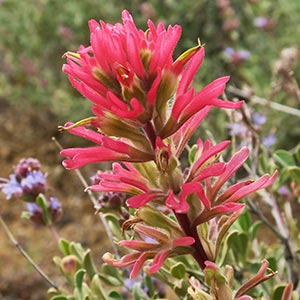Castilleja angustifolia
Castilleja fraterna
narrow-leaf paintbrush, northwestern Indian paintbrush, northwestern paintbrush, violet desert paintbrush
fraternal Indian paintbrush, fraternal paintbrush
few to many, ascending to erect, branched, especially near base, sometimes unbranched, hairs sparse to dense, spreading to retrorse, long, sometimes short, soft to stiff, usually mixed with short-glandular ones, sometimes viscid.
few to many, ± curved at base, ascending or erect distally, unbranched, hairs moderately dense, spreading, medium length and long, soft, mixed with shorter stipitate-glandular ones.
brown or purplish, sometimes green, linear to lanceolate or broadly lanceolate, 1.2–7(–7.5) cm, not fleshy, margins plane, sometimes ± wavy, involute or flat, (0–)3–5-lobed, rarely with secondary lobes, apex acuminate to rounded;
lobes spreading, oblong or lanceolate to linear-lanceolate, apex acute to rounded.
green, sometimes purple-tinged, lanceolate, broadly lanceolate, or narrowly ovate, 1–4.3 cm, not fleshy, margins plane, sometimes ± wavy, ± involute, 0–3-lobed, apex acute to acuminate;
lobes ascending, often narrowly oblanceolate, apex acute to acuminate.
2.5–20 × 1.5–5 cm;
bracts proximally greenish or dull purplish, distally pink, magenta, pink-purple, reddish pink, pale yellow, pale yellow-orange, pale orange, or white, rarely reddish or orange-red, lanceolate to oblong, 3–5(–9)-lobed, sometimes with secondary lobes;
lobes spreading or ascending, oblanceolate or linear, proximal lobes often much longer than distal, proximal lobes arising below or a little above mid length, apex acute to rounded.
3–8.5 × 1–4 cm;
bracts greenish or bright to sometimes dull red, sometimes scarlet, orange, or pale pink throughout, or proximally greenish, distally as above, ovate to elliptic, (0–)3-lobed;
lobes ascending, lanceolate to narrowly triangular, short, arising above mid length, apex acute to obtuse or acuminate.
straight, 18–27(–32) mm;
tube 8–17 mm;
beak usually long-exserted, adaxially green or pink, 8–15 mm;
abaxial lip deep green, reduced, inconspicuous, 1–2.5 mm, 5–20% as long as beak;
teeth incurved to ascending, deep green, 0.5–1.5 mm.
straight or slightly curved, 20–40 mm;
tube 27 mm;
abaxial lip often visible in abaxial cleft, sometimes exserted, beak usually exserted from calyx;
beak adaxially green to yellow, 8–14 mm;
abaxial lip red, black, green, white, or green and white, ± prominent, slightly rounded, 1.5–5 mm, ca. 33% as long as beak;
teeth ascending, green, bright red, pink, white, or yellow, 0.5–3 mm.
proximally green, yellow, brown, or purple, lobes colored as bract lobes, sometimes with a yellow band between proximal and distal parts, 13–25(–28) mm;
abaxial clefts 3–8 mm, adaxial 5–9(–12) mm, clefts 30–50% of calyx length, deeper than laterals, lateral (1–)1.5–4(–5) mm, 10–25% of calyx length;
lobes lanceolate to oblong, abaxials wider than adaxials, apex acute to rounded.
brightly, conspicuously colored for at least distal 2/3, often throughout, providing much of inflorescence coloration, proximally pale whitish to pale pink, distally colored as in distal portion of bracts, sometimes colored throughout as in distal portion of bracts, 15–30 mm;
abaxial and adaxial clefts 7–14 mm, 33–50% of calyx length, deeper than laterals, lateral 1–5 mm, 5–15% of calyx length;
lobes narrowly to broadly triangular, apex rounded to acute.
Castilleja angustifolia
Castilleja fraterna
Varieties 3 (3 in the flora).
Much confusion exists concerning Castilleja angustifolia and the closely related C. chromosa. Sometimes C. chromosa is treated as a variety of C. angustifolia, using the name C. angustifolia var. dubia. The latter name is used here to represent a different assemblage of plants, not including C. chromosa. At other times, C. chromosa is synonymized completely under C. angustifolia. However, the two species are in most cases easily separable, and where they are sympatric there is little evidence of intergradation. Both C. angustifolia var. dubia and C. chromosa are accepted here. See additional comments under 3b. C. angustifolia var. dubia and 15. C. chromosa.
(Discussion copyrighted by Flora of North America; reprinted with permission.)
Castilleja fraterna is endemic to one ridge system in the Wallowa Mountains of northeastern Oregon. A parallel ridge system in the range has a second Wallowa Mountains endemic, C. rubida. Castilleja fraterna is colored similarly to C. miniata, but the petaloid teeth of the abaxial corolla lip are more like C. chrysantha. It is possible that C. fraterna was derived through hybridization, though its chromosome number is unknown. It resembles the newly described C. kerryana in Montana.
(Discussion copyrighted by Flora of North America; reprinted with permission.)
1. Bracts distally usually pink to pink-purple; s Idaho, sw Montana, se Oregon, nw Wyoming. | var. angustifolia |
1. Bracts distally yellow, yellow-orange, pale orange, white, pink, reddish pink, or magenta; se Idaho, e Nevada, sw South Dakota, w Utah, ec Wyoming. | → 2 |
2. Bracts distally usually yellow to pale orange or white; ec Wyoming, adjacent sw South Dakota. | var. dubia |
2. Bracts distally usually yellow, yellow-orange, white, pink, or reddish pink; se Idaho, e Nevada, w Utah. | var. flavescens |


